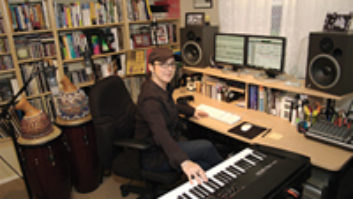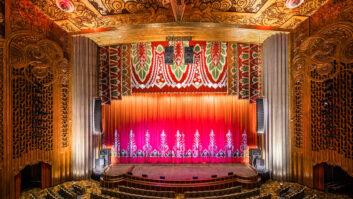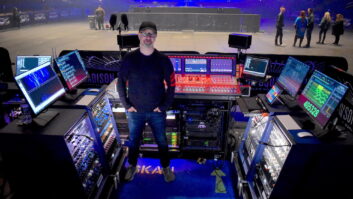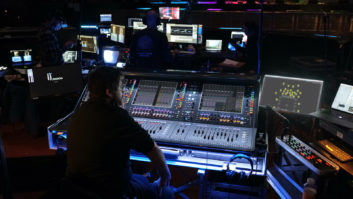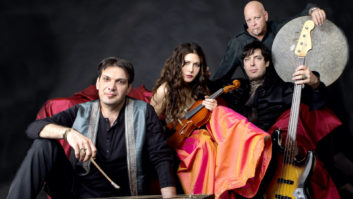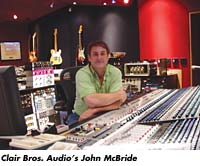
While the major record labels continue to lick their wounds (and
tally their losses) from a seemingly endless series of bloody
skirmishes with Internet pirates and others who would threaten their
previously unassailable sovereignty, the live music industry appears to
be thriving in many sectors, even as the dark clouds of the nation’s
general economic downturn roil overhead. Certainly, various businesses
associated with live sound — from regional rental companies to
bands themselves — have been tightening their belts and becoming
increasingly creative in their search for revenue sources. But there
doesn’t seem to be the same sense of
“what-the-hell-are-we-gonna-do?” panic that’s rippling
through the record companies.
“I think people are going to keep going to concerts and clubs
because you can’t download the concert experience — thank you,
God!” exults John McBride, general manager of Clair Bros. Audio
in Nashville. McBride founded MD Systems, which was absorbed by Clair
back in 1997. “It still feels good to go and see a band live.
Productions are getting better and better, and audio quality is getting
better all the time, too. People still want that experience.
“I’ve always felt that any act — and I don’t care how
many records you’re selling — can make 75 percent of their money
from touring,” he continues. “If you want to work hard,
you’ll make a lot more money from touring than from selling records.
But it’s a catch-22 because you’ve got to sell the records or have the
radio airplay to get the popularity to get people to come see you,
generally speaking. Certain people have gotten around that: Obviously,
Jimmy Buffett has been an incredible touring success without being on
the radio that much. And bands like Phish. But they’re the exception,
not the rule. Still, playing live can be a living.”
Because “live sound” encompasses so much — tiny
clubs, church installs, private corporate shows, mega-spectacles in
dedicated environments, the whole spectrum of touring acts that fill
theaters, civic auditoriums, arenas, sheds and stadiums — it’s
somewhat difficult to generalize about the state of the industry. Big
tours are earning more money than ever before (that’s good), mostly
because ticket prices have never been higher (that’s bad). All across
the country, new entertainment venues of all sizes are sprouting up,
providing excellent business opportunities for various categories of
sound professionals (that’s good). But current economic and market
conditions have made many fans of live music much more selective about
where they put their dollars so that more people are going to fewer
events (that’s bad). And some have stopped going out altogether,
preferring to cozy up at home with a DVD (a mixed bag, as sales of
concert DVDs have never been higher and thus, in a way, count as tour
revenue for a band).

“I see four fundamental forces driving change in what we’ve
traditionally known as live sound or tour sound,” comments David
Scheirman, director of tour sound for JBL, and for many years before
that a concert sound mixer and an audio journalist widely known for his
astute observations about the industry. “Number One is the
collapse of the support funding and talent development organizations at
the major record companies. Whether it’s EMI or Virgin or Sony or
Columbia, those companies are struggling to redefine how they develop
and deliver content to their markets. So the traditional funding for
tour support becomes harder to identify and access.
“Number two, there is an increased sensitivity by
concertgoers, music lovers and entertainment consumers to what you
might call ‘track acts,’ where choreography and personality
take precedence over musical content and talent,” he continues.
“I’m not implying there’s anything wrong with that, necessarily,
just that it redefines the production organization and vendors.
“A third macro trend is the maturing of baby boomer music
lovers now in positions of executive responsibility with civic
organizations, performing arts centers and venues of all types, and
corporate communications departments. So kids who were hitchhiking to
Cream concerts in the late ’60s are now on the board of directors of
performing arts centers or commanding major promotional budgets within
Fortune 500 companies. That changes the complexion of the rental
organizations who invest in sound equipment and who deploy it for these
sorts of events. Now it’s not at all unusual to have a State Farm
Insurance gathering or an American Dental Association convention with,
say, a six-day audio rental leading up to a climactic motivational
party/concert with Huey Lewis & The News or an Eddie Money or a
Sheena Easton. From the artist’s perspective, they no longer need to
support bus-riding, hard-working road employees as much as they need
A/V-savvy weekend warriors who can make sure they have a good show for
a fly date.
“A fourth trend is in video staging and lighting companies
that are establishing their own in-house audio departments. Those
people are wonderful customers [for JBL] because they don’t have a
pre-existing legacy of using brand X or Y speakers; they’re looking for
a good business investment. And that’s where JBL is often chosen as a
wise speaker system investment because of the brand’s durable
reputation. At the same time, we’ve also observed an increase in both
the quality and quantity of the inventory of regional sound rental
companies. These are people who are not trying to chase the brass ring
and go around the world with a band; they’re basically supplying events
that come into their locale. More of them have high-quality equipment
and the personnel to run it effectively.”
WHITHER TOUR SUPPORT?
There was a time, not so very long ago, when almost any act that was
signed by a major record label could count on being sent out on the
road for a “showcase” tour: major and sometimes a few minor
markets, mostly in clubs, with associated appearances in record stores
and radio stations. Now, it is much more common for labels to wait and
see which acts garner some interest from radio and retail (or MTV)
before committing money to even the smallest tour; again, the classic
record biz catch-22. As a result, some groups never get their showcase
tour; others finance it themselves, usually losing money in the
process.
There are other means to fund a tour, such as large or small
corporate sponsorship, which includes everything from playing the B
stage on a summer festival tour to headlining amphitheaters and having
a corporate logo in every ad, on every souvenir program and maybe even
on a banner hanging to the left of the drum risers. And then there’s
the slow regional build approach favored by so many groups in the
jam-band scene — taking the time to amass a regional following
before taking even tentative steps outside of your area.
Even with the record company cutbacks, though, “More acts are
working now than ever before,” says Billboard senior
touring writer Ray Waddell. “There are more choices, more venues.
Unfortunately, it’s a harder choice when you’ve got tickets up at $75
or $100 or more. You don’t experiment at that kind of price; you go to
people you know you like, which hurts artist development.” Still,
Waddell notes, “Ticket prices really leveled off this year after
a rapid escalation in the mid-’90s. There are more hundred-dollar [per
ticket] tours than ever, but I think there are more price tiers, and
some acts have actually dropped their ticket prices in hopes of
attracting bigger crowds.”
Generally speaking, the high-ticket tours have done well, whether
it’s The Eagles (who it could be convincingly argued started the trend
toward high-priced shows with their Hell Freezes Over tour
several years ago), Simon and Garfunkel or Fleetwood Mac — all
baby boomer acts exploiting their legacies and the fact that they have
older well-heeled fans who will pay top dollar.
Big package tours also keep rolling: “Lollapalooza did well in
major markets and struggled in the heartland,” Waddell says.
“Ozzfest did well again. That’s probably the most solid brand in
touring today, thanks in part to Ozzy’s amazing success. Metallica’s
Summer Sanitarium tour and Springsteen were the biggest stadium tours;
they both did really well. The KISS and Aerosmith pairing did great
business everywhere. Then there are groups like Phish and Dave Matthews
who seem to do well every year, no matter what else is happening. It
was a big year for rock, but there wasn’t a lot of pop out there. That
seems to be fading somewhat.
“Country also had a record year after a few years of downturn
because the superstars went out. Half-a-dozen country artists are going
to be among the Top 25 [for 2003]: George Strait, Kenny Chesney, Toby
Keith. Shania [Twain] is putting up a million dollars a night. The
Dixie Chicks have done fantastically well; the controversy [over their
thoughts about President Bush] didn’t seem to hurt them. Alabama’s
farewell tour has done great. Tim McGraw had a $50 million tour. Next
year, Faith Hill might go out, and Reba McEntire, too. So country is
really healthy, and more so because there are new headliners like
Chesney and Keith.”
THE WORK IS OUT THERE
Dave Shadoan, president of Sound Image, the huge Southern
California-based production, rental and contracting company, notes,
“Except in country music, the trend we’ve been seeing is a lot of
shorter tours. Some of it is probably economics, but some of it is also
how artists like to work now. A group like Blink-182 works for three or
four weeks, they take a month off and then work for a few more weeks.
People go out for 12 weeks now and they think they’re killing
themselves! Well, thank God for country music! Brooks and Dunn —
they’re out all year. Toby Keith, Rascal Flatts, Clint Black —
they’ve been out all year. That used to be the norm. Now, a lot of
people believe that 12 to 14 weeks in a summer make a career.
“Those bands that constantly aren’t on the road probably have
a more sane lifestyle than the ones that are,” Shadoan notes.
“But it’s tough on people like us, because we have to find quick
turnarounds. They might work May, June, July. But you’ve got to have a
place to put that system August through November. The toughest part of
our industry is maximizing your rental capabilities. We like to say
that 32 weeks is very good for any piece of gear. But in the big
picture, is 20 weeks of downtime on an investment what we would call
good business? I don’t think so. Of course, that doesn’t ring true on
everything, but it affects what we do. We make decisions based on that.
Do we want to spend $150,000 on a DiGiCo D5 or do we want to rent it
for a 12-week tour?”
Shadoan says that Sound Image just enjoyed “one of the
greatest years in the history of the company,” but he describes
the current economic climate in the sound business as “feast or
famine. I think there’s about the same amount of work as there has
been, but fewer organizations are getting it. Clair/Showco, us and
couple of other players have garnered a lot of the market. I’m not
saying that bigger is better, but in this kind of business climate,
people will go with a name they know and that has a good track record.
I know our client base has been fiercely loyal — hell, we’ve had
Jimmy Buffett for 29 years!”
The ever-expanding Clair Bros. empire has become a target of sorts
for other players in the industry, with some jealous competitors
predicting that the giant company will eventually find itself in the
same position as so many other corporate behemoths: slashing spending
to finance debt repayment, and centralizing operations at the expense
of regional charm and efficiency, losing that “human touch”
so vital in what nearly everyone agrees has been a people-to-people
business. But that clearly hasn’t happened yet, and McBride, for one,
says that merging with Clair was the best thing that ever happened to
his company, MD Systems.
“We’ve grown in leaps and bounds since the Clair acquisition.
Believe me, I looked at [the acquisition deal] long and hard prior to
making the decision. What it did was it gave all my guys a broader
base: It gave them a better benefits package than I was able to offer,
more job security and definitely more potential to go out and work
elsewhere, because now a guy who works here [in Nashville] might be out
six months from now on a U2 tour or could be on a Metallica tour,
because [Clair] pulls from the whole company.
“I’ve heard what people say about a company getting too big
and losing something; that does happen. But I believe in this instance,
with Clair and us and with the Showco merger, I feel like it’s improved
this company. We’ve become more efficient, more standardized. The
training has gotten better and better. We have an incredible gear pool
from which to pull. We ended up changing all our power distros, so we
have the same connectors, speaker cabling, amp racks — they all
work together.”
BLACK HATS AND NEW OPPORTUNITIES
On the tour promotion and production side, the great Goliath is, of
course, Clear Channel Entertainment, which is both the largest single
owner of music venues in the country and also the most successful
concert promoter in the business. (“It’s like owning a bridge
and collecting the tolls,” the late, great rock impresario
Bill Graham once crowed of owning his own shed, Shoreline
Amphitheatre.) A number of acts have tried to fight or bypass Clear
Channel, but to no avail. However, you’d be hard-pressed to find a
sound production company spokesperson who has anything bad to say about
Clear Channel on the record, and Billboard‘s Waddell, for one,
believes that “the guarantees they’ve thrown out there for bands
has created more touring, especially in light of other parts of
the business going down. The money has been better because of Clear
Channel, but the guarantees also translate into higher ticket
prices.”
For sound companies, the concerns are less about ticket pricing than
they are about nurturing their clients, finding new markets and keeping
up with changes in technology. The past decade-plus has seen a huge
number of new venues all across the country, but particularly in such
entertainment-rich communities as Branson (Mo.), Virginia Beach, and
the gambling centers of Las Vegas, Reno and Atlantic City.
“Las Vegas has become a great place to do box sales and
installs,” says Shadoan. “We’ve been doing installs there
for over 10 years, and we hope to increase our profile there even more
in the near future.” Las Vegas has seen the construction of
literally dozens of new theaters in the past few years, from custom
venues for Cirque Du Soleil and Celine Dion to showrooms of
every size.
Meanwhile, across the country in Atlantic City, “We’re booking
a really wide range of acts in a number of different-sized
venues,” says Steve Geitka, entertainment director of the Trump
Casino properties in that city and a one-time employee of Maryland
Sound. “We’ve been a good customer for a number of [sound]
companies. At Trump Taj Mahal, there’s a 5,000-seat arena in which we
have a Meyer MSL-3 system that covers a majority of what we do if it’s
a nontouring act. The other properties vary in size from about a
500-seat showroom up to a 1,400-seat theater. At Trump Plaza, there’s
the Plaza Theater that has a permanently installed EAW 850 [system].
The Taj Mahal also has a theater called the Xanadu, and that has a
Meyer MSL-2 system. At Trump Marina, there’s a 500-seat showroom called
the Shell and a ballroom for bigger acts that has about 1,400 seats,
and for both of those, we typically bring in a local audio contractor
called SPL, which is a great little company, and they’ll bring in a
[JBL] VerTec system or something.
“We get a lot of touring artists these days,” he
continues. “We’ve done Stone Temple Pilots and Staind and Puddle
of Mud — modern rock, which is a trend we started here back in
1997. We also just did Mariah Carey and Matchbox 20, and we’re going to
have Andrea Boccelli at the Taj Mahal. Just like in Vegas, there’s a
much broader market in casinos now than just the folks that would see
Paul Anka or Englebert Humperdinck or Lou Rawls. Of course, we book
them too, and we also have special shows where we’ll bring in acts from
Russia for Russians who come down here from New York and New Jersey; or
for Greeks, or for Asians. We’re trying to appeal to a lot of different
audiences. But we definitely want that younger rock audience —
the gamblers of tomorrow.”
BETTER, LIGHTER GEAR
Changes in sound system technology during the past few years have
led to more compact and efficient systems, including such modern
workhorses as the Clair I-4, Showco’s Prism System, L’Acoustics V-DOSC,
various Meyer rigs, the JBL VerTec and others. Likewise, sound
companies, venues, bands and consumers benefit from improved (and
lighter) power amps and various computer-based diagnostic and
processing tools that make room tuning and sound distribution more
precise: the Lake Contour system, the XTA 226, BSS 366 and dbx’s
DriveRack, to name a few.
“The costs of production and moving tours are so much higher
than it used to be, but I think there’s more bang for the buck in
production,” comments Billboard‘s Waddell. “You get
more sound from less speaker. The systems are more modular and fit on
the trucks much better. So a 15-truck tour from 10 years ago is an
eight- or nine-truck tour nowadays, and that’s been a reaction to
market conditions.”
“I’d like to say that the [QSC] PowerLight amplifiers have
reduced our trucking costs, but that’s not the case,” says John
“Klondike” Koehler, owner of Greenfield, Mass.-based
Klondike Sound. “The labor crews aren’t any smaller, since it
seems to be more about minimum calls, box counts and truck size than it
is about how much each piece weighs. Honestly, I don’t think there’s
been any economic benefit from the trend toward lighter systems. I
don’t think anyone that is now bringing in VerTec, which is two-thirds
the weight of V-DOSC, is doing so with a smaller labor call. It’s a big
P.A., you get your 12 guys; that’s the call.”
As the head of a smaller sound company, Koehler has a slightly
different perspective than his brethren at larger outfits, one that’s
perhaps more representative of the vast majority of companies across
the land. He says that these are challenging times.
“Speaking to my market here in New England, the small-theater
market is in a slump. Most of the 1,000-seat halls are producing far
fewer shows than they were two or three years ago, and the ones they
are producing do not require as much hardware. The colleges are also in
a slump when it comes to entertainment budgets. Most college
administrators have realized that parents will kick in a few bucks for
kids to go to a local club or dance to a DJ in the dorm basement, but
they’re just not producing concerts in gymnasiums and field houses the
way they used to.
“That said, our spring and summer schedules are incredibly
busy,” Koehler says. “If you were talking to me in May
[instead of November], I would have hung up the phone five minutes ago
because I would be too busy to have a conversation. We do an enormous
number of commencements and summer festivals — the Philadelphia
Folk Festival and Newport Folk, Newport Jazz. There are over a dozen
multistage, multiday festivals with audiences in the 20,000 to 30,000
range that we cover every summer, typically one or two a weekend. But
the small-theater and college markets, which used to provide us with
another 200 shows a year, and also independent promoters — like
arts councils and culturally minded citizens who have a budget of
$10,000 or so from the town or city to do, say, a Christmas show and
one pop show — we’re probably down to a third of what we did in
the ’80s and ’90s just because of budget concerns.” For nearly
two decades, Klondike has also been audio director of the New Orleans
Jazz and Heritage Festival, an event that is apparently
recession-proof.
What can turn things around for businesses like Klondike that are
feeling the pinch of a tough economy? “I think it pretty much
starts in the White House,” Koehler says. “I’m hopeful
there will be a renaissance all the way around when it comes to people
wanting to celebrate together. That’s really what we do —
facilitate celebration on a large scale. If folks are feeling tentative
about their lives and their futures and prefer to stay at home and push
Play, we’re not going to be seeing the activity levels that we enjoyed
in the ’90s.”
Blair Jackson is Mix‘s senior editor.


